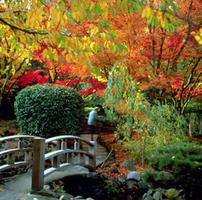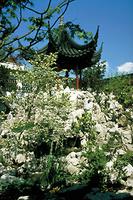Botanical Garden
A botanical garden is distinguished from a public park or display garden (eg, Butchart Gardens, BC) by having a documented collection of woody or herbaceous plants on which scientific research and teaching are conducted. Arrangement of plants within a botanical garden is often made according to a botanical evolutionary sequence, or by geographic origin, special use or function. If the collection consists primarily of woody plants, it may be called an arboretum.
Exactly what constitutes a botanical garden is debated among professionals. A very conservative view is a scientific garden of this kind must be associated with a university in order to fulfill its objectives as an educational and research facility. Such a definition would restrict the number of Canadian botanical gardens to only 4 (University of British Columbia, University of Alberta, Laurentian and Memorial).
At the other end of the spectrum several societies have been formed around private plant collections, billing themselves as botanical gardens even though they may have no horticultural staff, and operate entirely with part-time volunteers. Such gardens are usually limited to plant display. An acceptable interpretation of a botanical garden falls somewhere between the 2 extremes, and included some fine botanical gardens associated with municipalities. Canadian gardens form part of the American Association of Botanical Gardens and Arboreta and participate in the International Association of Botanical Gardens.
First Botanical Gardens
The early herbal or physic gardens were created by physicians and students of medicine to grow plants having medicinal or pharmaceutical properties. The first botanical gardens devoted to broader studies of plants, including those of both economic and horticultural significance, were developed in Italy: in Pisa (1543) and Padua (1545). Shortly thereafter, botanical gardens were established in Leipzig, Germany (1580); Leyden, Holland (1587); and Montpellier, France (1593).
In the 17th and 18th centuries, many gardens were founded to examine scientifically new plants introduced to Europe. Governments saw the potential of developing these plants as crops. The importance of botanical gardens in the introduction of new crop plants is exemplified by the Royal Botanic Garden, Kew, England (established 1759), which pioneered the development of rubber, banana, tea, pineapple, coffee and cacao.
Many botanical gardens continue to introduce new plants, emphasizing both economic and ornamental varieties. The tradition of systematic botany (classifying and identifying plants) continues, and recent ecological studies are providing a better understanding of plant resources, particularly of rare and endangered plants.
Development of Canadian Botanical Gardens
The first botanical garden was established in 1861 by George Lawson at Queen's College (now Queen's University) in Kingston, Ont, but it lasted only until the 1870s. In 1886 the Experimental Farms Act of the federal Department of Agriculture was passed and, one year later, an arboretum and botanical garden was initiated at the former Central Experimental Farm, Ottawa. Other research- and display-oriented gardens were later developed by the department at other stations.
The second university botanical garden was established at Vancouver by John Davidson in 1916. It continues to thrive as a separate academic service department of the University of British Columbia. The city of Montréal established the Jardin Botanique before WWII; it is now one of the major world gardens. The Royal Botanical Gardens in Hamilton were established in 1941. The postwar period saw several new gardens develop as population centres increased. A review of some Canadian botanical gardens follows.
British Columbia
UBC Botanical Garden (44.5 ha), including Nitobe Memorial Garden, Lohbrunner Alpine Garden, Asian Garden and BC Native Garden, operates a program of plant introduction to the nursery industry and an active educational research program. Van Dusen Botanical Display Garden (established 1972, 22 ha), operated by the Vancouver Board of Parks and Recreation, specializes in displays of ornamental plants and offers educational programs with the Vancouver Botanical Garden Association.
Alberta
Devonian Botanic Garden, University of Alberta, Edmonton (established 1959, 77 ha), devotes special attention to alpine and native plants and conducts research on the hardiness of ornamental perennials and woody plants.
Ontario
Royal Botanical Gardens, Hamilton (809 ha), comprises a series of attractively landscaped gardens within a larger natural woodland setting, including Katie Osborne Lilac Garden, Iris Garden, Centennial Rose Garden, Rock Garden and Trail Garden of Annuals. The garden includes extensive natural areas and operates active educational and research programs.
Agriculture Canada Arboretum and Botanic Gardens, Ottawa (established 1887, 55 ha), has some of the oldest cultivated woody specimens in Canada that have been evaluated for hardiness. Rose, hedge and rock garden annual and perennial test gardens are also present. Laurentian University Botanical Garden, Sudbury (established 1972, 7 ha), specializes in native plants of the region.
Québec
Jardin botanique, Montréal (established 1931, 73 ha), operated by Service des Parcs de la Ville de Montréal, includes outstanding conservatory displays, particularly bromeliads, orchids, ferns, gesneriads, aroides, cacti and other succulents, and a tropical rain forest. Extensive outdoor display gardens feature such specialties as taxonomic, economic, aquatic and medicinal gardens.
Newfoundland
Oxen Pond Botanic Park, Memorial University, St John's (established 1972, 34 ha), contains specialized display gardens, including a garden to attract butterflies, set in a natural woodland setting.

 Share on Facebook
Share on Facebook Share on X
Share on X Share by Email
Share by Email Share on Google Classroom
Share on Google Classroom










